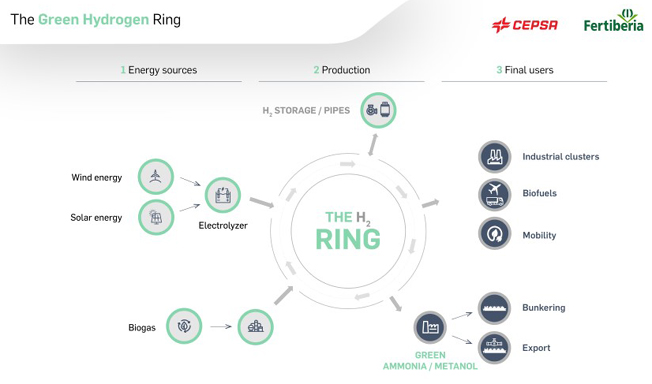The agreement will allow the two companies to independently meet the green hydrogen consumption target for industry set by the government for the whole of Spain by 2030
- This is the largest agreement signed to date, as they are Spain's top hydrogen producers and consumers, accounting for more than a third of national consumption
- The two companies will further invest into the development of the Andalusian Green Hydrogen Valley in Huelva to jointly optimize their decarbonization plans, including the production of green hydrogen and other renewable gases
- They will create a pioneering circular economy for hydrogen production, ensuring the supply of the new renewable energy vector to the area's entire industrial fabric and strengthening synergies between their plants
- As a part of the agreement, they will also consider production of renewable fuels (green methanol and ammonia) in Huelva and other provinces in mainland Spain
Cepsa and Fertiberia, two of Spain's largest hydrogen consumers, have reached an agreement to decarbonize their production processes by jointly developing a large-scale renewable hydrogen plant in Huelva using green energy and other renewable gases. The companies will also implement other industrial synergies between their Huelva sites.
Through this union, Cepsa and Fertiberia have become strategic partners in the project to develop 1 GW of electrolysis capacity in Palos de la Frontera as part of the Andalusian Green Hydrogen Valley.
This valley will have a 2 GW capacity—1 GW in Campo de Gibraltar (Cádiz) and another in Palos de la Frontera (Huelva)—and production of up to 300,000 tons in Cepsa's Energy Parks.
The agreement will meet the hydrogen and biogenic CO2 needs of both companies’ facilities in the industrial fabric of Palos de la Frontera (Huelva) in the most optimal way. Green hydrogen production will begin in 2026, and it will be used for Cepsa's and Fertiberia's own industrial consumption while enabling the manufacture of advanced biofuels, ammonia, AdBlue and sustainable crop nutrition solutions.
Cepsa's La Rábida Energy Park is adjacent to Fertiberia's facilities in Palos de la Frontera. Therefore, the partnership will help to leverage all existing industrial and operational synergies between the two sites, allowing them to be managed as efficiently as possible.

The alliance will allow a circular hydrogen and oxygen economy to be developed in Huelva. The construction of this infrastructure will be a pioneering engineering project, connecting hydrogen producers with consumers to ensure a more sustainable, efficient and competitive energy supply. It will take advantage of synergies between all nearby industries while guaranteeing their secure supply.
Upon signing this agreement, Maarten Wetselaar, CEO of Cepsa, said:
"We are adding a new strategic partner to the Andalusian Green Hydrogen Valley to continue promoting the decarbonization of industry in Huelva and make it a benchmark for sustainability in Europe. Our agreement with Fertiberia is a major step forward in our commitment to green hydrogen as a key energy vector to decarbonize our own activity and that of our customers."
According to Javier Goñi, CEO of Grupo Fertiberia,
"Our alliance with Cepsa is significant, as it implies a collaboration between the two companies with the longest industrial tradition in the province of Huelva and which account for nearly all the hydrogen consumption in Andalusia today. This alliance will make Huelva's green hydrogen production more competitive, becoming a source of opportunities for multiple companies along the value chain. It will also further the full decarbonization of our assets and our positioning as a leader in green ammonia and sustainable crop nutrition solutions."
The Hydrogen Roadmap, established by the Spanish government, sets a target for 25% of hydrogen consumption in industry to be renewable by 2030, both as a raw material and as an energy source. Through this agreement, Cepsa and Fertiberia will decarbonize their consumption by using green hydrogen, jointly meeting the target set for the whole of Spain by the end of the decade.
As a part of their agreement, the two companies will also consider producing renewable fuels (green methanol and ammonia) in both Huelva and other provinces in mainland Spain.
This new alliance is part of Cepsa's 2030 Positive Motion strategy, through which the company is transforming itself to become a benchmark in the energy transition, leading sustainable mobility in Spain and Portugal, as well as the production of renewable hydrogen and advanced biofuels. Cepsa will promote the decarbonization of its customers, as well as its own activity, reaching net zero emissions by 2050.
For Fertiberia, this alliance represents a new milestone in its strategy to accelerate the growth of its green ammonia production and to become the first company in its sector worldwide to achieve carbon neutrality by 2035. Fertiberia already markets the Impact Zero product line, which contributes to the decarbonization of food and beverage production while promoting fully sustainable agriculture in Europe.
The alliance between Cepsa and Fertiberia contributes to several of the 2030 Agenda’s Sustainable Development Goals: SDG 7 (Affordable and clean energy), SDG 8 (Decent work and economic growth), SDG 12 (Responsible consumption and production), and SDG 13 (Climate action).
KeyFacts Energy: Cepsa Spain country profile
 KEYFACT Energy
KEYFACT Energy